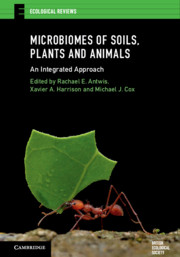Book contents
- Microbiomes of Soils, Plants and Animals
- Ecological Reviews
- Microbiomes of Soils, Plants and Animals
- Copyright page
- Contents
- Contributors
- Preface
- Abbreviations
- Chapter One Microbiomes of soils, plants and animals: an introduction
- Chapter Two Analytical approaches for microbiome research
- Chapter Three Microbiomes of soils
- Chapter Four Factors that shape the host microbiome
- Chapter Five Microbial symbioses and host nutrition
- Chapter Six The microbiome and host behaviour
- Chapter Seven Host microbiomes and disease
- Chapter Eight Adapting to environmental change
- Chapter Nine Microbial biotechnology
- Chapter Ten Synthesis and future directions
- Index
- Plate Section (PDF Only)
- References
Chapter Four - Factors that shape the host microbiome
Published online by Cambridge University Press: 07 March 2020
- Microbiomes of Soils, Plants and Animals
- Ecological Reviews
- Microbiomes of Soils, Plants and Animals
- Copyright page
- Contents
- Contributors
- Preface
- Abbreviations
- Chapter One Microbiomes of soils, plants and animals: an introduction
- Chapter Two Analytical approaches for microbiome research
- Chapter Three Microbiomes of soils
- Chapter Four Factors that shape the host microbiome
- Chapter Five Microbial symbioses and host nutrition
- Chapter Six The microbiome and host behaviour
- Chapter Seven Host microbiomes and disease
- Chapter Eight Adapting to environmental change
- Chapter Nine Microbial biotechnology
- Chapter Ten Synthesis and future directions
- Index
- Plate Section (PDF Only)
- References
Summary
Host-associated microbiomes are ubiquitous in nature, but highly variable in both space and time, and shaped by a diverse range of biotic and abiotic factors. This chapter summarises the numerous drivers of variation in microbiome structure and function across both plants and animals. Plants harbour distinct microbial communities in their rhizosphere, phyllosphere and endosphere. These communities interact with hosts in a different way, and in turn are shaped by a unique set of environmental factors. For example, the rhizosphere supports a particularly diverse microbial community shaped by plant exudates and signalling molecules to facilitate nutrient transfer to the host. Similarly, variation in animal microbiomes is driven by host genetic, life-history and environmental traits, including phylogeny, diet, age, metabolism and sociality. Several of these factors are also given more detailed treatment in later chapters. Particular attention is given to our current state of knowledge concerning initial colonisation and subsequent succession in microbial community composition in juveniles, the consequences of which remain one of the major outstanding questions in microbiome research.
Keywords
- Type
- Chapter
- Information
- Microbiomes of Soils, Plants and AnimalsAn Integrated Approach, pp. 55 - 77Publisher: Cambridge University PressPrint publication year: 2020
References
- 3
- Cited by



